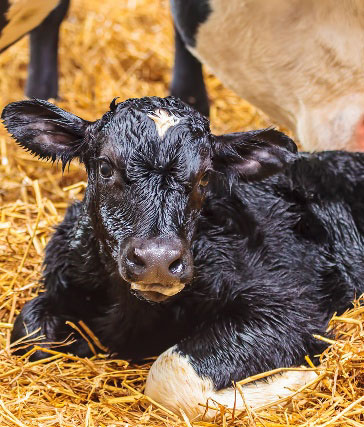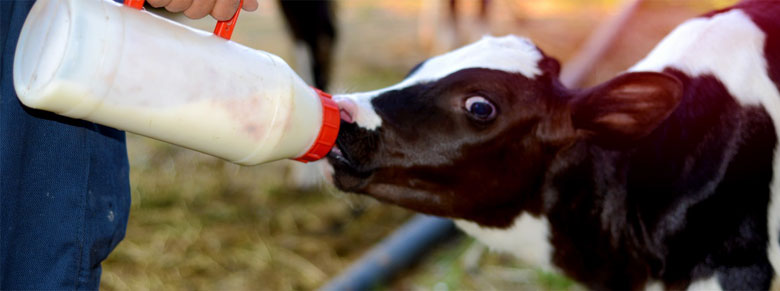- The Transition Period - October 10, 2016
The transition period, the weeks leading up to and following calving, are the most stressful in a dairy cow’s life. One of the major determinants of whether a cow transitions successfully is her ability to maintain adequate blood calcium status during this time. It is all too apparent when a cow exhibits clinical hypocalcemia (milk fever) and is actually down. The silent profit drain is the effect on those cows that experience subclinical hypocalcemia with blood calcium levels dropping below the industry-accepted threshold of 8.5 mg/dL. These cows are at higher risk for developing metabolic and infectious disease after calving. Fortunately, the physiology of fresh-cow calcium status is becoming better-understood all the time and it can be effectively managed.
The metabolic and physiological demands for calcium increase dramatically at calving. The calving process, colostrum production and milk synthesis all demand calcium at a level that often exceeds the available calcium in circulation. Calcium is essential for normal cellular activity and cell function of almost all cells. Cells of the immune system are no different, leading to impaired immune function in cows suffering from subclinical hypocalcemia.
 There are several strategies employed to maintain blood calcium concentrations over 8.5mg/dL post-calving. The most successful involve manipulating the dietary macro-mineral ions chloride, sulfur, sodium and potassium. By feeding a diet higher in negative ions (chloride and sulfur) and lower in positive ions (sodium and potassium), the cow’s blood becomes mildly acidic. This stimulates the physiological processes that lead to mobilization of bone calcium stores and intestinal uptake of dietary calcium required to meet the demands necessary for a successful transition. This nutritional strategy is referred to as a Dietary Cation Anion Difference (DCAD) diet or an “acidified” diet. It is particularly important to use a very palatable source of negative anions as any reduction in pre-partum intake will have negative effects on fresh cow health.
There are several strategies employed to maintain blood calcium concentrations over 8.5mg/dL post-calving. The most successful involve manipulating the dietary macro-mineral ions chloride, sulfur, sodium and potassium. By feeding a diet higher in negative ions (chloride and sulfur) and lower in positive ions (sodium and potassium), the cow’s blood becomes mildly acidic. This stimulates the physiological processes that lead to mobilization of bone calcium stores and intestinal uptake of dietary calcium required to meet the demands necessary for a successful transition. This nutritional strategy is referred to as a Dietary Cation Anion Difference (DCAD) diet or an “acidified” diet. It is particularly important to use a very palatable source of negative anions as any reduction in pre-partum intake will have negative effects on fresh cow health.
“Checking urine pH regularly while feeding a DCAD diet is very important,” states Seth Johnson, Dairy Technical Specialist with Phibro Animal Health. “Checking weekly will allow you to see changes in the TMR or the forages that shift the DCAD. It’s nice to be able to head off problems before you have sick cows in the fresh pen.”
Phoenix Feeds nutritionists have used a blood calcium testing program in cooperation with Phibro Animal Health Corporation, makers of Animate Anionic Supplement, to effectively evaluate blood calcium levels on a herd level. Samples are taken 48 hours after calving.
“We’ve found that this timing allows evaluation of the level of recovery in calcium status at the point when cows should be above the subclinical threshold if they are to start a healthy, productive lactation,” states Johnson.
Very low levels of subclinical hypocalcemia are found in herds with excellent nutrition and management of pre-fresh cows.
“The value the testing brings me is confidence that the feed program designed is working properly,” reports Phoenix’s David Burnham. “Along with that, it gives me the confidence the diet is getting fed right, the forages are staying consistent and are what the sample says they are. Beyond that, if the dairy is still having metabolic issues, it helps me to focus on other road blocks that could be causing issues—such as bare-bunk syndrome, feed push-ups, overcrowding, etc.”
“We check blood calcium on cows that freshen with seemingly no issues to verify that their calcium status is not limiting their performance,” reports Johnson. “This allows us to show some herds that there is room for improvement in their fresh cow program even when fresh cow issues seem to be at an ‘acceptable’ level.” A fully acidified diet can drastically reduce fresh cow issues, saving a farm significantly in health costs and helping cows peak higher and produce more over the course of a lactation.
This article first appeared in Perspectives Magazine Summer 2016 issue.

